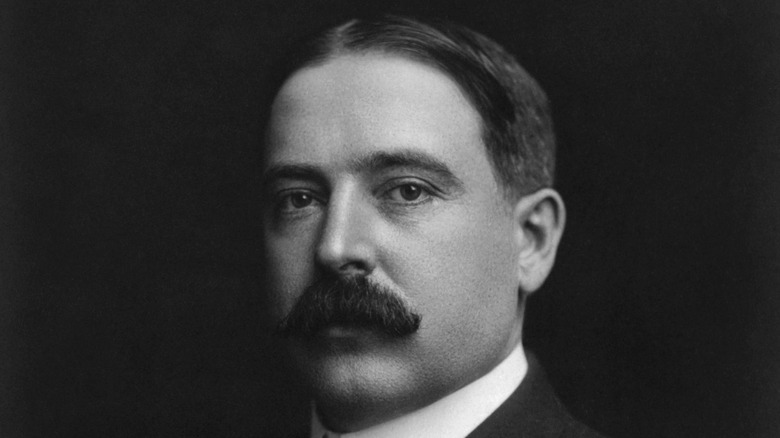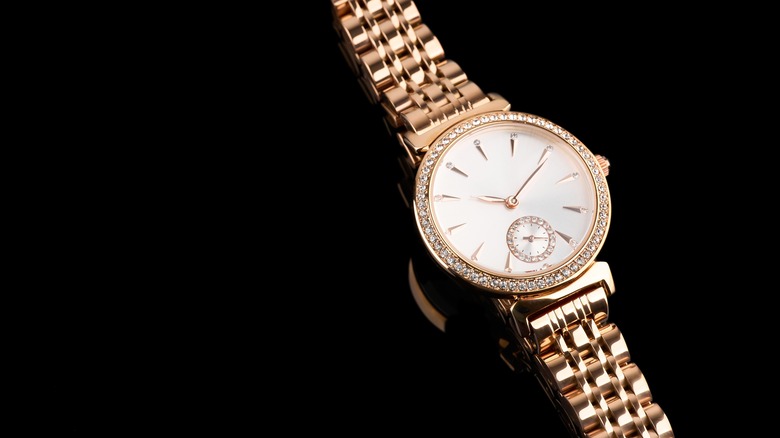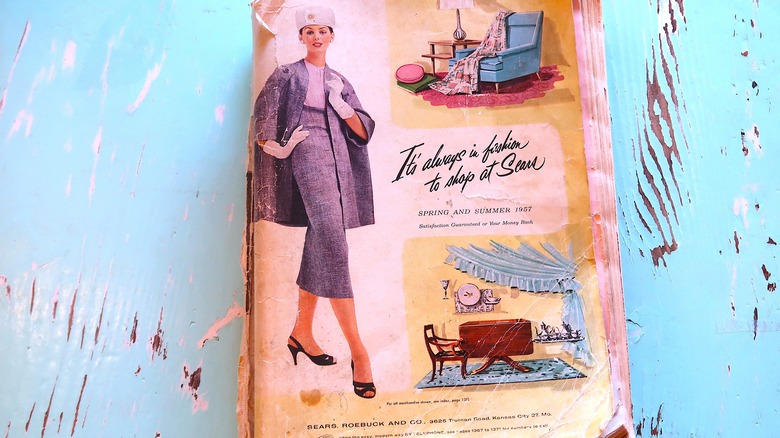Was There A Real Person Named Sears?
Many of us know Sears as the massive, mall-based department store our parents saw as a go-to for all Christmas shopping, necessities, appliances, and more. Kids grew up getting their back-to-school clothes there, while other shoppers have left with larger purchases — lawnmowers, refrigerators, treadmills, televisions, etc. But did you know it started out as a mail-order jewelry and watch company? Even more interesting, its first profitable goods were a bundle of watches that didn't make the cut (via Britannica).
While it's more commonly known as just "Sears," you have probably heard of "Sears, Roebuck and Co." And that's because there actually was once a Sears, a Roebuck and, well, there still is a co. While its founders are long gone, their legacy remains, and it has grown from a few watches being transported through the post, ordered via personally-written fliers, to the mega store and corporation that it is today.
The Early Life of Richard Warren Sears
Richard Warren Sears was a small town boy, born and raised in the state of Minnesota (via Spring Valley Methodist Church Museum). He was born in Stewartville in 1863 but moved to Spring Valley with his parents in 1872 around the age of 9. According to historical records, his father — James — came into some wealth through wagon sales, but then lost it all (via Britannica). He also served in local government as a councilman.
James had allegedly lost his money through a $15,000 stock venture and died not long after, leaving little behind for his young family (per Spring Valley Methodist Church Museum). Sadly, Richard was just a boy at the impressionable age of 17 (some say 16). To support his family — his mother, Eliza, and two sisters — he began work as a telegrapher. Then, he went on to work long hours as a railway station agent in Minneapolis, and after that, in Redwood Falls, where he found a bit of luck.
First Watch(es)
While working for the Redwood Falls railway as a station agent, Richard Warren Sears came across a shipment of watches that were rejected by the package's intended recipient, a local jeweler (via Britannica). He was instructed to dispose of the shipment, but instead, he took the phrase "another man's trash is another man's treasure" quite literally. He started a makeshift watch business via mail, marketing the accessories by letters he wrote to fellow workers at other railway stations.
Then in 1886, with the quick $5,000 he made through this chance exchange (considering the generous discounts he gave to his colleagues), he founded the mail-order, Minneapolis-based jewelry company that started it all. It was originally called the R.W. Sears Watch Company, and he operated it alone — creating all marketing and literature for it. But soon after came the Roebuck in "Sears, Roebuck and Co.," just before up and moving the operation to the big city.
Alvah Roebuck
A year after founding R.W. Sears Watch Company, Richard Warren Sears met a young watch repairman by the name of Alvah Roebuck (via Britannica). He hired him upon deciding to take the show on the road to a completely different state and city: Chicago, Illinois. And that's exactly where he found Roebuck in a Chicago newspaper's help-wanted ad (via Sears Archives).
Roebuck became enamored with mechanical workings at a young age. He was already considered a self-taught watch-maker in his teens, and by 22, he was working for a local jeweler. Then, in 1887, he applied for the position that went down in history as his first big break — receiving a response from Sears two days later with the intent to hire him (per Sears Archives). By 1893, Roebuck was an official partner, but in 1895, he had actually asked Sears to buy him out. In response, Sears promoted him to the head of watches, jewelry, optical goods, phonographs, motion picture machines, and more. He is now considered a co-founder.
Creative Catalogs Started it All
Those very first watches Richard Warren Sears sold during his days as a railway station worker were marketed by mail to his colleagues at other stations (via Britannica). Many say his personal appeal, creativity, knack for sales, and persistence didn't stop there — he is credited for quite literally writing the playbook for Sears as we know it today (via Spring Valley Methodist Church Museum).
As of 1893, when Sears' company was just getting started, the catalog — written primarily by him — was about 196 pages (per Britannica). It included ads for various goods, ranging far from its roots of watches and jewelry to sewing machines, shoes, instruments, and more. In just a year, the page count nearly tripled to 507. Sears was a creative at heart, not only authoring the catalogs but also creating all advertisements and marketing for newspapers, magazines, and other media. The company's reliance on mail-order systems grew so large that they built a plant dedicated solely to mail orders in 1906 (per Spring Valley Methodist Church Museum). At the time, the Chicago building was the largest business building in the world.
The Demise of a Duo
While Sears is still a household name — a chain that used to have hundreds of stores now only has about 170 in the United States as of 2022 (via Scrape Hero). Yet, Sears, Roebuck and Co. is still known as just that, despite its founders stepping down (via Britannica) and passing on long ago (via Sears Archives).
Richard Warren Sears began experiencing health problems at the young age of 45, likely due to stress from tireless overworking. Some cite that he experienced Bright's disease (via Jane Addams Digital Edition), now known as "nephritis," which is an inflammation of the kidneys caused by toxins, infection, or autoimmune disease (via University of Leeds). Just a few years after retiring in 1908, he died at the young age of 51 in 1914, leaving behind nearly $25 million (via Spring Valley Methodist Church Museum). He was buried in Rosehill Cemetery in Chicago (via Find A Grave) long before he ever got to see the first major Sears department store open in 1925. His partner, Alvah Roebuck, lived a full life — having passed away at 84 years old in 1948 (per Sears Archives).





